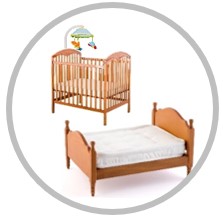Investigation Spotlight: Fiberglass and Mattresses
 Problem
Problem
In 2021, the California Department of Public Health (CDPH) investigated a report of a child whose skin and breathing were harmed by exposure to fiberglass that came out of their mattress. CDPH discovered that numerous individuals had filed similar complaints with the
U.S. Consumer Product Safety Commission.
Breathing in fiberglass can irritate the nose, throat, and lungs and cause breathing problems. Fiberglass can also irritate the eyes and skin. Fiberglass is made of thin glass fibers, which are sometimes woven into a cloth. The glass fibers are stiff and break easily into tiny pieces and settle into dust. Fiberglass is used in some mattresses to prevent them from catching on fire. It is used instead of chemicals as a fire retardant.
Investigation
CDPH tested four twin-size and baby-size mattresses for fiberglass. Two of the mattresses tested contained fiberglass: the Zinus 6" Green Team Memory Foam twin mattress and the Graco Crib & Toddler Deluxe mattress. The label on the Graco mattress did not reveal that it contained fiberglass. Both the Zinus and Graco mattresses displayed a safety label by CertiPUR-US. However, CertiPUR-US only certifies the safety of the foam inside a mattress, it does not certify the safety of other materials inside a mattress.
Outcomes and impact
CDPH published its study on fiberglass and mattresses (2022) and developed a factsheet on fiberglass and mattresses in English and Spanish.
In October 2023, Governor Newson signed into law a state-wide ban on the sale of mattresses and upholstered furniture that contain fiberglass. The ban will go into effect on January 1, 2027.
Resources